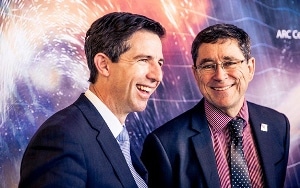Nov 10 2017
Minister for Education and Training, Simon Birmingham, has opened the Australian Research Council’s $31.3 million Centre of Excellence for Gravitational Wave Discovery at Swinburne.
 Senator Birmingham with OzGrav director Professor Matthew Bailes at the launch of the new $31.3 million centre. (Credit: Swinburne University of Technology)
Senator Birmingham with OzGrav director Professor Matthew Bailes at the launch of the new $31.3 million centre. (Credit: Swinburne University of Technology)
The centre, known as OzGrav, has been established to capitalise on the 2015 discovery of gravitational waves, which resulted recently in the awarding of the 2017 Nobel Prize to three US physicists, Professors Kip Thorne, Rainer Weiss and Barry Barish.
Senator Birmingham says that OzGrav will play a critical role in keeping Australia at the leading edge internationally of gravitational wave research and discovery.
“This facility builds on decades of Australian investment in gravitational wave and pulsar science and merges research activities by Australian and international researchers into a focused national program,” he says.
“The Centre of Excellence will help equip researchers with cutting edge technology to further advance research across multiple disciplines, from lasers and radio instrumentations to big data and astronomy.”
Swinburne will host OzGrav in collaboration with five other universities – Australian National University, the University of Western Australia, Monash University, the University of Melbourne and the University of Adelaide – as well as prestigious international partner organisations such as MIT and Caltech.
The launch included a video-link congratulations from Nobel Laureate Professor Barry Barish who told the packed lecture theatre that Australian gravitational wave scientists had played an integral role in all international gravitational wave discoveries to date.
At the launch, director of OzGrav, Professor Matthew Bailes, gave the audience an interactive walk-through the discovery of gravitational waves, saying the centre is an opportunity to bring together gravitational wave researchers from across Australia.
He describes gravitational wave astronomy as the “hottest topic” in astronomy at present.
“The field is just two years old,” he says.
“This centre is Australia’s chance to maximise its involvement in the dawn of this new area of astrophysics.
“It will give Australian scientists and students the opportunity to fully participate in the birth of gravitational wave astronomy.
“It will also enable us to develop amazing technologies like quantum squeezing to further enhance the detectors, supercomputers and advanced algorithms to find the waves, and these will lead to a revolution in our understanding of the Universe.”
Gravitational waves
Gravitational waves were first predicted by Albert Einstein about 100 years ago in his Theory of General Relativity. Einstein’s theory described how gravity warps and distorts space-time.
His mathematics showed that massive accelerating objects - such as neutron stars or black holes – that orbit each other distort both space and time and emit a type of radiation known as gravitational waves.
Einstein did not believe gravitational waves would ever be detected.
A century later, they have been.
In September 2015, the California-based observatory specifically established to search for gravitational waves first sensed gravitational waves. The observatory is called aLIGO, short for the Advanced Laster Interferometer Gravitational-Wave Observatory.
Shortly after being switched on in 2015, aLIGO sensed distortions in space-time. These distortions were caused by passing gravitational waves that generated more than one billion years ago when two black holes collided.
Last month, the three US Professors who led the way in discovering gravitational waves were awarded the 2017 Nobel Prize for Physics.
Soon after, OzGrav researchers made another significant announcement - a further detection of gravitational waves from the death spiral of two neutron stars.
This recent announcement adds significant weight to the importance of OzGrav as the centre of gravitational wave research in the region.